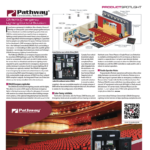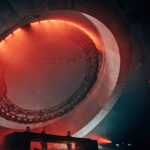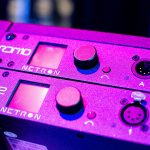Roland’s V-800HD Multi-Format Video Switcher may have eight mixing buses instead of 16, and four SDI inputs instead of eight. But like Roland’s V-1600HD, it lets users tap into a wide variety of analog and video sources, manipulate the imagery and display clean, sharp video, even on large LED displays.
With both units, users don’t need to worry about matching input sources to output resolution. Both are multi-format video mixers. Every input has its own broadcast-quality scaler that can individually scale, stretch, crop and zoom each source as required to fit any output resolution chosen.
I/O Options
Similar to the V-1600HD, the V-800HD works with a wide variety of formats, including 3G/HD/SD-SDI, DVI-A/DVI-D/HDMI, RGB, component and composite formats, plus an additional two channels for still images assignable via USB memory stick or frame grab. The output connectors include RSG/Component for projectors and other video devices that accept only analog input.
Built-in scalers also let users specify resolutions that differ from the main output resolution. The SD output provides a constant down-scaled composite signal regardless of the main output resolution. It is also equipped with two DVI-D/HDMI outputs for connecting displays/projectors, and the unit also supports HDCP out. There are also two SDI outputs supporting 3G, HD and SD signals. Also, a built-in multiviewer output lets users monitor the status of all input sources, along with the Program and Preview outputs. The Multiviewer output also can make use of an HDMI connector, which can be useful for preview purposes.
The V-800HD’s internal processing design allows for output up to 3G SDI, and its 4:4:4/10-bit internal signal processing gives users compositing and output with no reduction in the high-detail RGB signals driven from a computer. That translates to cleaner, sharper video and text, even on large LED displays.
HDCP Compliant
The V-800HD is an HDCP compliant switcher — a big advantage when the content being played is encoded with HDCP (High-bandwidth Digital Content Protection).
Although legacy switchers might not be compatible with HDCP, which would prevent them from playing, for example, a Blu-ray disc with protected content, the V-800HD lets users select HDCP from the menu and turn the mode to ON. A panel indicator lets them check the operating state when the unit is in the HDCP mode.
A new key-compositing engine also lets users fine-tune color-phase centering, adjust phase range and fine-tune the amount of chroma and HSV color space parameters. Another key compositing feature includes an external keyer, enabling CG titles and gradation clips and other visual effects.
The V-800HD lets users set assignable video cross-points to reorder channel buttons on the bus. This is especially useful when sudden changes in camera lines or differences in formats create blank spaces between select buttons on the bus. A dedicated composite output enables a down-converted SD signal that is always ready to use for archiving to a DVD recorder or to an encoder for streaming.
The Multi-zoom function allows one video input to be shared internally with up to three more inputs — essentially daisy-chaining it. The scaler for each input can zoom into any position in the video image, giving the appearance that additional cameras are connected. Because it can create a virtual multi-camera environment with just one camera source, it promises to be particularly useful for live musical performances or corporate events where users want to offer a variety of camera angles to the audience.
The V-800HD can be controlled via MIDI or RS-232. Users can connect two V-800HDs using MIDI or RS-232, allowing more mixing channels to be used together in tandem. The V-800HD also supports MIDI Visual Control, allowing electronic musical instruments to control switch and effect parameters for a synchronized audio and video musical performance. There is also a BNC input for external reference synchronization when used in combination with existing production-studio system equipment.


